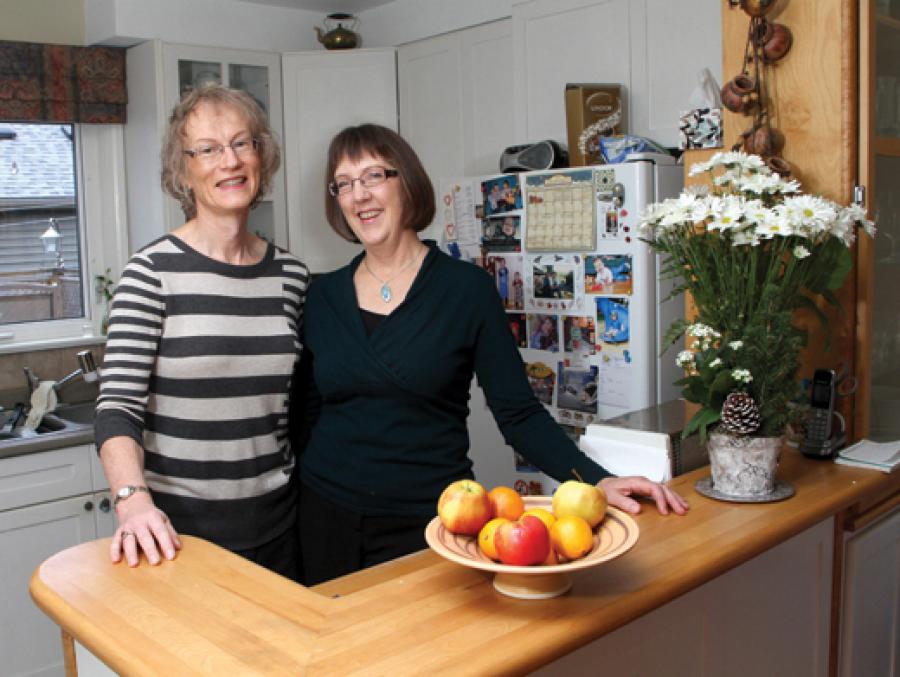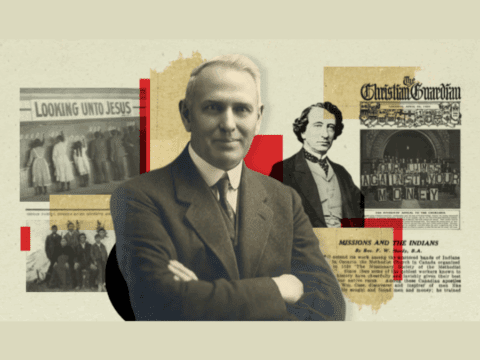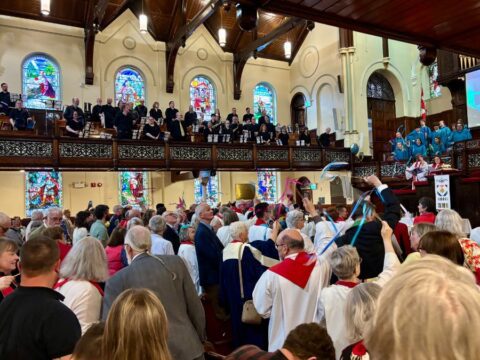Ruth Wood, a 59-year-old grandmother, sits at a well-used wooden card table in the hall of Calvary United in Kingston, Ont. She’s wearing a nicely cut navy suit jacket, floral blouse and silver tulip-shaped broach. Her short hair curls gently around her face. She touches her earlobes self-consciously. “I was in such a hurry this morning that I forgot my earrings. I never do that,” she says softly. It’s hard to believe that just five years ago, Ruth was a man.
Ruth is here to discuss how her world turned upside down in those five years. Hers is a story of change so profound it’s hard to fathom. It is also the story of how Ruth’s partner and the churchgoing people in their community were challenged to reach deep into their faith. Ruth Wood is the first United Church minister to have transitioned from one sex to another while serving a congregation.
“Our life was the picture of normal until Terry came out,” says Ruth’s wife, Anne, in the couple’s living room in Kingston. She met Ruth, then Terry, at a United Church youth group. They became high school sweethearts. Terry studied mechanical technology at Algonquin College; Anne studied life sciences at Queen’s University. They married 37 years ago, had two children and now have five grandchildren. Then Terry came out. “It was like life as I knew it stopped. It was like I couldn’t live in the past or the future. I was sort of nowhere,” Anne says.
Ruth isn’t sure when she first knew she was born in the wrong body. It dawned on her later than most. “I would read a story about someone who is transsexual and wonder, but I immediately shoved it right back into my subconscious,” she says. Then, nine years ago, Ruth enrolled in the designated lay ministry program at United Theological College in Montreal. The courses required deep introspection. One night in the summer of 2007, she found a website about being transgender. She had an epiphany. “My heart finally knew, ‘That’s who I am,’” Ruth says. But just as soon, there was a crushing realization. “My head said, ‘Do you know what this means?’” She divulged to her spiritual adviser and prepared to tell Anne two weeks later.
Anne never saw it coming. She combs through her memories. There weren’t any signs. Unlike some transsexual people, Ruth wasn’t leading a double life or secretly dressing in women’s clothes. The first clue came just two weeks before Ruth told her. She had shaved her arms and legs.
Ruth was gearing up to share her news with Anne. She waited until they both had a free night and dove in, telling Anne she needed to talk to her after dinner. “Anne knew something serious was happening. She thought the worst that could happen was that I was leaving her. I’m not sure if today she would say that that was the worst that could happen,” says Ruth.
Anne doesn’t remember that life-changing conversation over the kitchen table. It’s a blur. Shock and denial flooded in. She thought Terry was mistaken, maybe delusional, maybe mentally ill, maybe having a breakdown. She walked around in a stunned daze. Ruth told her that some transsexual people commit suicide in the transitioning process. At the time, Anne didn’t know that Ruth herself was suicidal.
Ruth wanted to die. Constantly wrestling with her identity was exhausting. The uncertainty of the future was unbearable. She knew she couldn’t go back to her old life. “It would have been like dying while still alive,” she says. She saw a psychotherapist weekly for a year. “It took a year to come to grips with it, to understand it and to carry on.”
One Friday night about six months after Ruth disclosed her secret to Anne, she asked Anne if she could dress in feminine clothes for dinner. Anne had just returned from a stressful day at the busy financial office where she worked. She lost it, and the matter was dropped.
A full year passed before Anne was ready to see Ruth in women’s clothes. She shakes her head at the memory of Ruth coming downstairs in a summer dress. “It was surreal,” she says. The more Ruth was becoming herself, the more Anne felt that her own world was slipping away. Anne grieved for her husband and her “normal life.” Would she lose her friends? What would her neighbours think? Would people assume they were gay? What about the church? How would they tell her mother? What would this do to their kids? Taking off the summer dress that night, Ruth slipped into bed. She looked at Anne and said, “I guess you are probably saying goodbye and I’m saying hello.”
In 2009, Ruth drove to the gender identity clinic at the Centre for Addiction and Mental Health (CAMH) in Toronto. Her biggest fear was that she would be rejected for gender reassignment surgery because as a “late bloomer” she didn’t fit the typical profile. It was a relief to hear the staff say, “We don’t tell you who you are. You tell us who you are.” In the end, she qualified. She was elated. She was finally going to have the body she wanted. But she would have to live as a woman for two years before she could have surgery. That meant she needed to come out. The sooner the better.
Anne had already told a couple of her closest friends. Their immediate reaction was that she should leave Ruth. The advice wasn’t helpful. She hadn’t made up her mind whether she would stay or go and couldn’t conceive of abruptly ending her marriage. Anne hid her devastation from everyone who mattered to her. She felt utterly alone. At church, she watched Ruth preach and feared that the congregation would see the same changes she was keenly cataloguing: hair growing out, the smoothing effect of electrolysis, the changes in the way Ruth carried herself. Anne reached out to a life coach for support, started gathering Internet material to make an information package for her family, and waited for the right time to tell them. The couple delayed sharing the news as their daughter’s marriage broke up and their son married. Finally, they called a family meeting.
The family convened in the living room on the comfortable couch in front of the fireplace. A family friend played with their two-year-old grandson in the yard while they talked. There were many questions: Was this something Ruth could manage privately? How would their dad look? When did Ruth begin feeling this way? Both kids “did as well as anyone could expect,” Ruth says. They turned to Anne for support as they struggled.
Ruth’s children still call her Dad. “That’s who I am to them,” she says. “I’ll always be their dad.” One day her daughter told her, “I love you and support you, but I really miss having a dad who looks like a dad.” Asking the kids not to share the news with their family and friends was also hard, Anne says. They couldn’t risk the churches finding out before they figured out how to tell them.
How does a minister tell his congregation that he is really a she? At the time, Ruth was serving as a designated lay pastoral minister at Calvary United and a nearby church on Wolfe Island, each on a half-time basis for six and seven years respectively, all through the upheaval of her personal life. “I couldn’t tell them. I just felt that I had to keep going. I had to be a professional and act as if nothing was wrong. It was horrible,” she says. Beginning in 2009 and through early 2010, Ruth spoke with the Conference personnel minister and told a handful of key Presbytery people. “I didn’t want to drop a bombshell in the Presbytery’s lap,” she says.
Together, they mulled over various plans. Ruth didn’t think it was fair to the congregations to come out between Advent and Easter, and she felt it would be easier for them to hear the news in person rather than in a public meeting. Because the Calvary congregation was quite small, she could visit each one individually. But it was not possible for her to do the same at Wolfe Island, so she made personal visits to three members of the Board and asked them each to visit 10 others. At the same time, the Presbytery would call a meeting to discuss the situation with each congregation and to hear their thoughts and concerns. Ruth would be nearby in case they asked for her. She arranged pulpit supply for the following Sunday, and Presbytery and Conference representatives planned to attend the service.
As it turned out, Ruth met with three couples at Wolfe Island and then began to visit the parishioners at Calvary, each time steeling herself for rejection. “Nothing is for certain when you come out,” she reflects. “You don’t know what your neighbour will say, what your family will say, what your employer will say, what your family doctor will say. You have no predictor that everything is going to be all right, and you just have to go ahead anyway.”
Two Sundays later, Ruth returned to the pulpit at Calvary United, preaching the lectionary, same as always. She never returned to Wolfe Island. A couple of weeks after receiving her letter, they asked for her resignation. She gave it to them. There was no formal goodbye. Ruth says she understands why she was asked to resign. “I had had several years to come to the point where I could accept myself. I wasn’t expecting anyone off the bat to say, ‘Yep, no problem.’ I am just grateful that one congregation agreed to journey with me, to take a chance that we might be able to work through this.”
Anne admits that she felt angry for a long time about the dismissal. “It felt like it was a rejection, not just of Ruth, but because we are so close, a rejection of me.” Losing the church community and a significant source of family income were two more losses to endure.
The first Sunday back at Calvary, Ruth decided to wear a women’s suit jacket and do her hair in a slightly more feminine style. Baby steps. Some good friends from the Presbytery came for support. No one said too much. They tried not to stare. One congregation member gently turned to Anne: “You always looked so sad and I didn’t know why.” The memory of that small gesture brings Anne to tears.
The surgery clock was ticking. Now that she was out, Ruth wanted to leap into the female gender role, but she had no idea how to be a woman. “No one needs to teach a boy or a girl how to be male or female. You are taught by your parents, your culture. If I was going to ‘pass’ [be perceived in the proper gender role], then I had to pick it up quickly.” Men can’t change their voice with hormone therapy, and it bothered Ruth when people mistook her as male on the phone. So she studied women’s voices and tried to mimic their cadence. She practised walking without the male “swagger.” She hounded Anne with questions about all things feminine. She’s still amazed at how long it takes to get ready in the morning.
Staff at Toronto’s gender identity clinic told Ruth that it would be easier for people to accept the transition if she had a new name. She chose Ruth, after the biblical character. “It’s a big story for me. Obviously Ruth had her life turned upside down. Her husband dies. Her livelihood disappears. She had to make a decision whether it was better to stay in her old life or risk setting out on a new one where she would be a disrespected foreigner in a land she didn’t know or understand.”
Clothes, hair, gait, voice, name: piece by piece, Anne watched the husband she knew erode. While Ruth felt her transition was excruciatingly slow, to Anne it was painfully fast. Always ahead in the process, Ruth would wait to make a change until Anne was ready.
Anne occasionally has difficulty with pronouns. So do others. Ruth understands. “Some people slip and call me Terry. That’s okay,” she says. “But in some cases, people don’t call me Ruth because they don’t think I should have changed my name, and I have a lot of trouble with that. That hurts.”
Ruth had gender reassignment surgery in Montreal this past August. Her penis was recrafted to form female genitalia, and she had breast augmentation. Anne stood by Ruth and is helping to nurse her back to health. She is adjusting to the new Ruth.
“Euphoric” is the word Ruth uses to describe finally having a body true to her spirit. Being able to shower at the gym and have a passport and licence that match her appearance is helpful, too. “No one wakes up and says, ‘I think I’ll be different,’” Ruth observes. But she has no regrets, save one. “If I could change anything, it would be the pain my family has experienced. They had to go through a lot of angst that I would never have wished on them. Never. That’s the painful part.” Her voice cracks with emotion.
Ruth is on a yearly appointment at Calvary United. When her reappointment first came up, she was worried. “I wondered, ‘What if they think this is just too weird and we would just like to have things normal?’ I would understand that. I would like to have my life normal. Anne would like to have her life normal. Our children would like to have their lives normal. But we can’t go back. The congregation can. They can say, ‘We want normal back.’” Early in 2012, Calvary reappointed Ruth, just as they have for the past eight years.
It’s been a difficult year. Anne’s mother died recently, suffering from Alzheimer’s disease. Anne asked the minister to help at the funeral by telling family friends about Ruth’s transition. Still, there was one couple who didn’t know. “How do you tell someone about this in a receiving line at a funeral? What do you say? ‘You remember my husband, Terry? Well, meet Ruth,’” she says, laughing. “I would have been mortified by that a few years ago. Now, I realize that I can’t control people’s reactions.”
Today Anne focuses on who Ruth is rather than who she isn’t. “I used to feel that there were three people in my marriage: me, Terry and Ruth. I couldn’t reconcile this person in women’s clothes with Terry. I focused on the differences. Now, I’m seeing Terry and Ruth as not so separate, as one and the same person. It’s getting much easier.”
This story originally appeared in the February 2013 issue of The Observer with the title “Becoming Ruth Wood.”














